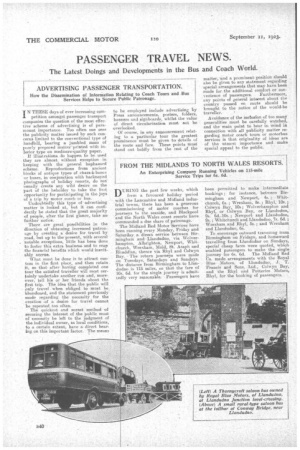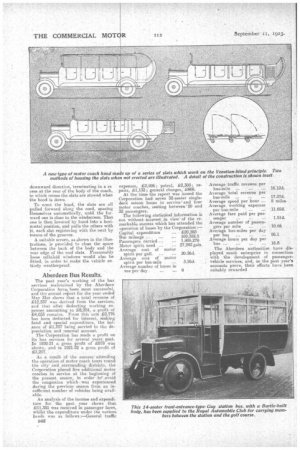PASSENGER TRAVEL NEWS.
Page 26

Page 27

Page 28

If you've noticed an error in this article please click here to report it so we can fix it.
The Latest Doings and Developments in the Bus and Coach World.
ADVERTISING PASSENGER TRANSPORTATION.
How the Dissemination of Information Relating to Coach Tours and Bus Services Helps to Secure Public Patronage.
IN THESE days of ever increasing competition amongst passenger transport companies the question of the most effective scheme of advertising is of paramount importance. Too often one sees the publicity matter issued by such concerns limited to the conventional type of handbill, bearing a jumbled mass of poorly prepared matteeprinted with inferior type on mediocrequality paper. If illustrations do happen to be used they are almost without exception in keeping with the general haphazard scheme. Reproductions from ancient blocks of antique types of chars-à-bancs or buses, in conjunction with hackneyed photographs of holiday resorts, do not usually create any Wild desire on the part of the beholder to take the first opportunity for participating in the joys of a trip by motor coach or bus.
Undoubtedly this type of -advertising matter is looked at, but it can confidently be stated that the great majority of people, after the first glance, take no further notice.
There are great possibilities in the direction of obtaining increased patronage by creating a desire for travel by road, but up to the present, with several notable exceptions, little has been done to foster this extra businessand to reap the financial benefits which would inevitably accrue.
What must be done is to attract custom in the first place, and then retain it, so that after having completed one tour the satisfied traveller will most certainly undertake another run and, moreover, tell his or her friends about the fret trip. The idea that the public will "only travel when obliged to must be hbandoned, and the statement previously', made regarding the necessity for the creation -of a desire for travel cannot be repeated toe often. The quickest and surest method of securing the interest of the public musk of necessity be left to the judgment of the individual owner, as local conditions, tp a certain extent, have a direct bearing on this important factor. The means
to be employed include advertising by Press announcements, posters, folders, banners and signboards, whilst the value of direct circularization must not be overlooked.
Of course, in any announcement relating to a particular tour the greatest prominence must be given to details of the route and fare. These points must stand out boldly from the rest of the matter,-a.nd a prominent position should also be given to any statement regarding special arrangements that may have been made for the additional comfort or convenience of passengers. Furthermore, any points of general interest about the country passed en route should be brought to the notice of the would-be traveller.
Avoidance of the inclusion of ton many generalities must be carefully watched, and the main point to bear in mind in connection with all publicity matter regarding motor coach tours or motorbus services is that. originality of ideas are of the utmost importance and make special appeal to the public.
FROM THE MIDLANDS TO NORTH WALES RESORTS.
An Enterprising Company Running Vehicles on 115-mile Service Trips for 6s. 6d.
DURING the past few weeks, which form a favoured holiday period with the Lancashire and Midland industrial towns, there has 'been a generous commissioning of motor coaches for journeys to the, seaside, and Blackpool 'and the North Wales coast resorts 'have commanded a. due share of patronage.
The Midland Red Motor 'Services have been running every Monday, Friday and Saturday a direct service between Bir-. mingham and -Llandudno, via Wolverhampton, Albrighton, Newport, Whitchurch, Wrexham, Mold, St. Asaph and Rhuddian, thence via Rhyl and Colwyn. Bay.. The return journeys were made on Tuesdays, Saturdays and Sundays. The distance from Birmingham to Llandudno is 115 miles, so that the fare of 10s. 6d. for the single journey is admittedly very reasonable. Passengers have
been permitted to make intermediate bookings; for instance, between Birmingham and Newport, 4s. ; Whitchurch, 6s. ; Wrexham, 8s. ; Rhyl, Ns.; Celwyn Bay, 10s; Wolverhampton and Rhyl, or Colwyn Bay, or Llandudno, 9s. 6d.-10s. ; Newport and Llandudno, 9s. ; Whitchurch and Llandudno, 7s. 6d. ; Wrexham and Rhyl, 5s. ; and Wrexham and Llandudno, bs.
To -encourage outward travehung trom Birmingham on Fridaysand homeward travelling from Llandudno on Sundays, special cheap fares were quoted,, which enabled passengers to 'make the single, journey for 6s. 6d. The Midland Red Co. made arrangements with the Royal Blue Motors, of Llandudno, J. T. Francis and Sons, Ltd., Colwyn Bay, and the Rhyl and Potteries Motois, Rhyl, for the booking of passengers.
This summer has witnessed consider. able extensions in the bus services of North Wales, and opinion is divided as to whether or not these developments have detracted from the interest that is usually taken in the shorter runs. The immved services, however, have had this advantage—they have provided passengers who have wished to spend part of their holidays at less-frequented and less-accessible spots, with the meani to do so, for the railway services of North Wales are not too good.
The buses have by no means detracted from the appeal of the day or half-day trips, which, being purely sight-seeing excursions, take passengers to destinations which are only accessible by road. Furthermore, the lure of successful advertising, which is one of the features
the North Wales owners do concentrate upon, will always ensure for Motor coaching a freshness. that is perhaps unattainable in other .parts of the country. If the Llandudno owner devises a en-cular tour of the mountains, he does not blazon it forth that he is running "a cheap circular tour. Fare, 7s. 6d." No He is mare adroit. It is a "New Alpine Tour," "A Mountain Loop," or some other such phrase which quickens the imagination.
One distinctive feature of the Llandudno motor coaching trade is that each owner vigorously asserts his identity. Each fleet has its own colour— the Reds, Blues, Creams, Silvers, Purples, etc.— colours which are flaunted everywhere.
Motor coaching fares at Llandudno have been maintained throughout the season at about lid. per mile.
A SLATTED COACH HOOD.
A New Type of Covering Built on the Venetian-blind Principle Which May Assist in the Solution of a Difficult Problem.
THE ...DESIGN of motor coach hood which we illustrate on the next page has beea patented. by Messrs. Harding, of Ilfracombe, and is. interesting in that it is clearly one outcome of the feeling, which is prevalent amongst a good many
coach proprietors, that it would be a good thing if the flexible Cape-cart type of covering were to be superseded by something a little more substantial and less liable to be torn as the result of slight contact with obstructions which are al most unavoidable when the hood is disposed at the rear or sometimes when it is in the raised position. The principle of the Venetian-blind has been incorporated in the construction of the roof, which is supported on runners mounted on pillars, wfiich may be either telescopic or designed to disappear into the hollow walls of the body of the vehicle when the hood is not required.
Some light but rigid material, such as papier miche, duralumin, celluloid, or leather, is suggested as being suitable for the slats of the roof. Each slat is stipported, at its front edge, on d roller, which engages, at its ends, in the interior channels of the aforesaid runners. Grooves are formed, near the front and rear edges of the slat,the rear groove' of each being designed to engage with the front one of the slat. behind,' the objecg being to make the joints between them watertight.
The cords which, in a Venetian-blind, serve to vary the angle of the slats, have thei counterpart in this hood roof; in a couple of wires which run from the rear end to the windscreen of the vehicle. ..A. pull oh these cords, which are attached to the _rear edges of all • the slats, lifts them into a Vertical position, when they may readily be closed back upon one another and towards the rear of the vehicle; following the course of the runners, which are prolonged at the back in a
downward direction, terminating in a re case at the rear of the body of the coach, in which recess the slats are stowed when the hood is down.
. To erect the hoed, the slats are all pulled forward along the cord, spacing themselves automatically, until the for-ward one is close to the windscreen. That one is then lowered by hand into a horizontal position, and pulls the others with it, each slat registering with the next by means of the grooves.
A suitable screen, as shown in the illustrations, is provided to close the space between the back crf the body and the rear edge of the roof slats. Presumably loose celluloid windows would also be fitted, in order td make the vehicle entirely weatherproof.
Aberdeen Bus Results.
The past year's working of the bus services maintained by -the Aberdeen Corporation have, been most successful, and the annual report for the year ended May 31st shows that a total revenue of £12,257 was derived from the services, and that after deducting working expenses amounting to £8,224, a. profit of £4,033 remains. From this sum £2,776 has been deducted for interest, sinking fund and special expenditure. the balance of £1,257 being earned to the depreciation and renewal account.
The Corporation has .made a profit on its bus services for several years. past. In 1920-21 a gross profit of £878 was shown, and in 1921-22 a gross profit. of £3,207.
As • a result of the success attending the operation of motor coach tours round the city and surrounding districts, the Corporation placed five additional motor coaches in service at the beginning of the present season, in order te avoid the congestion which.was experienced during the previous season from an insufficient number of vehicles being available.
An analysis of the income and expenditure for the past year shows that £11,351 was received in passenger fares, whilst the expenditure under the various heads was as follows :—General traffic 1342 expenses, £3,926; petrol, £2,300; repairs, £1,132; general charges, £966. At the time the report was issued the Corporation had. seven 32-seater singledeck saloon buses in service rand four motor coaches, seating between' 20 and 32 passengers. The following statistical information is 'not withoutinterest,in view' of the remarkable success which has attended the operation of buses by the Corppration :— Capital expenditure ... £20,283 Bus mileage ... ... 169.352.5 Passengers carried ... 1,8(15,279 Motor spirit used .. ... 27,242 gals. Average cost of motor spint per gall. ... 20.26d. Average cost of motor spirit per bus-mile ... 3.26d. Average number of buses in use per day. 9 Average traffic revenue per
bus-mile ... ... 16.12d. Average 'total revenue per bus-mile ... ... 17.37d. Average speed per hour ... 8 miles Average working expenses per bus,-mile ... 11.65d. Average fare paid per pas
senger ... 1.51d. Average number of passen 96.1 Average hours per day per bus ... 16.8 The Aberdeen authorities have displayed much enterprise in connection with the development of passenger. vehicle services, and, as the past year's accounts prove, their efforts have,been suitably rewarded


































